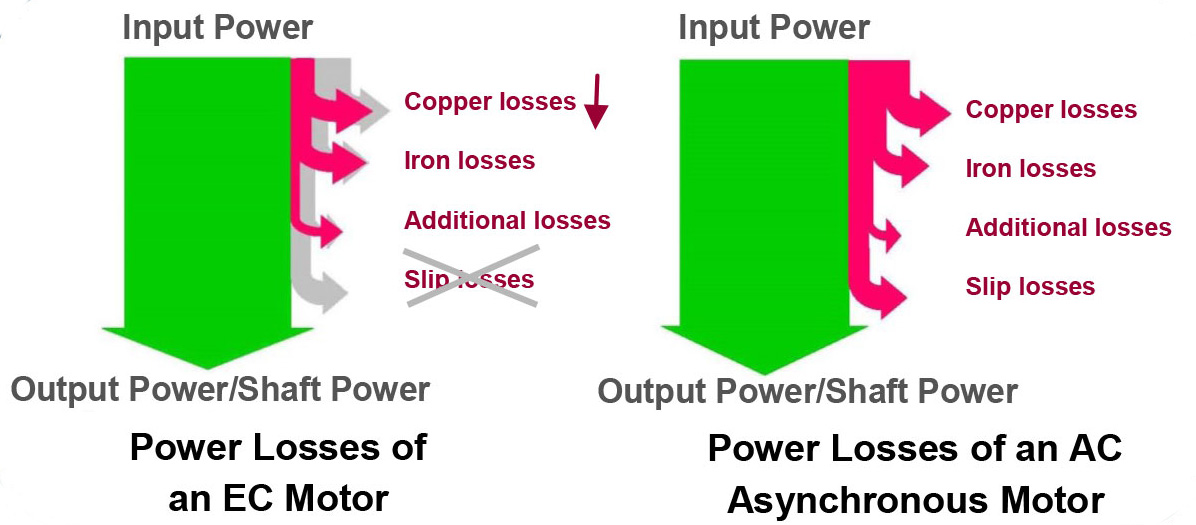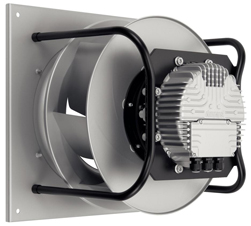Deciphering motor terminology can be frustrating, especially when comparing the operation and performance of various motor types. For example, some motors are characterized by their speed (synchronous or asynchronous) while others are characterized by their commutation method (brushed or brushless). And then there’s the issue of whether the motor is operated with AC or DC power — but even this seemingly simple distinction can be misleading. Case in point: “DC” motors use a DC power supply, but the current is switched to AC in order to feed the motor windings, so some experts argue that these motors should, technically, be placed in the same category as motors that run on AC power. And just when you think you have the terminology and specifications all figured out, along comes another name or acronym, added to the mix.
In the motion control world, a relatively new motor distinction that is becoming more widespread is the term “electronically commutated,” or “EC,” motor. So how does this “new” EC motor fit into the existing hierarchy?
The short answer is, EC motors are not a new technology. They are simply permanent magnet brushless DC (BLDC) motors that are being distinguished by their method of commutation (i.e. electronic) rather than by their physical characteristic of lacking brushes. These motors, whether referred to as “brushless DC” or “electronically commutated,” have a permanent magnet rotor with a wound stator. Electronics determine the sequence for commutation, or energizing of the stator windings, based on the rotor position, which is most often provided by either three Hall sensors or a rotary encoder (although there are methods of determining rotor position without additional feedback devices).

Image credit: Think RC/JP Commerce, LLC
A quick google search of “EC motor” or “electronically commutated motor” reveals that this terminology is used extensively in the HVAC and refrigeration markets, especially for equipment such as fans, blowers, and compressors — all of which have traditionally been powered by AC induction motors.
Recall that AC induction motors operate via AC current provided to the stator, which creates a rotating magnetic field. This field induces a current, and therefore a magnetic field, in the rotor. The stator and rotor magnetic fields rotate at different speeds (aka “asynchronous”) to generate torque. While inexpensive and easy to operate, AC motors’ two main operating characteristics result in reduced efficiency when compared to BLDC, aka EC, motors. First, inducing current in the rotor windings increases power consumption, and second, the difference in speed between the magnetic fields — known as “slip” — causes heat generation. This inefficiency has not gone unnoticed by the United States Department of Energy.

Image credit: H.C. Nye Co.
BLDC, or EC, motors have high efficiency over a range of speeds, rather than a high peak efficiency at a single speed.

Image credit: ebm-papst
This report, published in 2013, details the Department of Energy’s analysis of power consumption in the U.S. The report shows that residential and commercial end uses account for approximately 39 percent of annual energy consumption, with the industrial sector accounting for approximately 32 percent. (Transportation makes up the remaining 28 percent.)
The report then goes on to discuss opportunities and barriers to reducing overall energy consumption — primarily by increasing the efficiency of motor-driven systems and components in commercial and residential applications. One of the key ways to achieve this is by replacing the motors traditionally used in these applications — primarily AC induction motors — with higher efficiency motors — namely, EC designs.
This statement from the report explains…
For almost all equipment types in both the residential and commercial sectors, the market is transitioning to permanent magnet motor technology for the highest-efficiency models within each category. Permanent magnet motors are becoming increasingly cost-effective based purely on simple payback period. They also offer other non-energy benefits such as reduced noise and the ability to reach higher rotational speeds.
In fact, the DOE’s most recent Small Motor Efficiency Rule and Integral Horsepower Motor Rule, together with various DOE rules specific to HVAC and refrigeration equipment (think blowers and compressors) as well as to pumps and fans, have compelled motor manufacturers and equipment OEMs to transition from AC induction motors to EC motors in many types of applications and equipment.
So, if an EC motor is really just a BLDC motor by a different name, why add another term to the already complex hierarchy of motor nomenclature? One reason may be to avoid confusion for those who are most familiar with AC motors and might associate any DC motor with the brushed designs that dominated the DC motor market for many years. Using the term “electronically commutated,” rather than “brushless DC,” makes it less likely that users will confuse the modern, high-efficiency, long-life motors with brushed designs, which suffered from poor efficiency, frequent maintenance, and reduced service life.
Another reason can be found in the DOE publication cited earlier. There, the agency specifies (emphasis added):
In general, ECMs refer to low horsepower BLDC motors that have integrated drives and controls and are commonly found in HVAC applications.
Here, the agency makes a distinction between permanent magnet, brushless DC motors with separate drives and controls (BLDC motors) and those that have integrated drives and controls (EC motors). However, some manufacturers and OEMs clearly use the terms “EC motor” and “BLDC motor” interchangeably when describing a permanent magnet, brushless DC motor, regardless of whether the drives and controls are integrated into or separate from the motor.
Since numerous manufacturers of EC (BLDC) motors supply not only to the HVAC and refrigeration markets, but also to the motion control market, it’s no surprise that the terms “electronically commutated motor” and “EC motor” are permeating the motion control lexicon. And if it helps reduce the confusion between BLDC, PMSM, BLAC, and the plethora of other motor names and acronyms out there, that can only be a good thing for those of us tasked with decoding the jargon to evaluate and specify the best design for our application.







Leave a Reply
You must be logged in to post a comment.